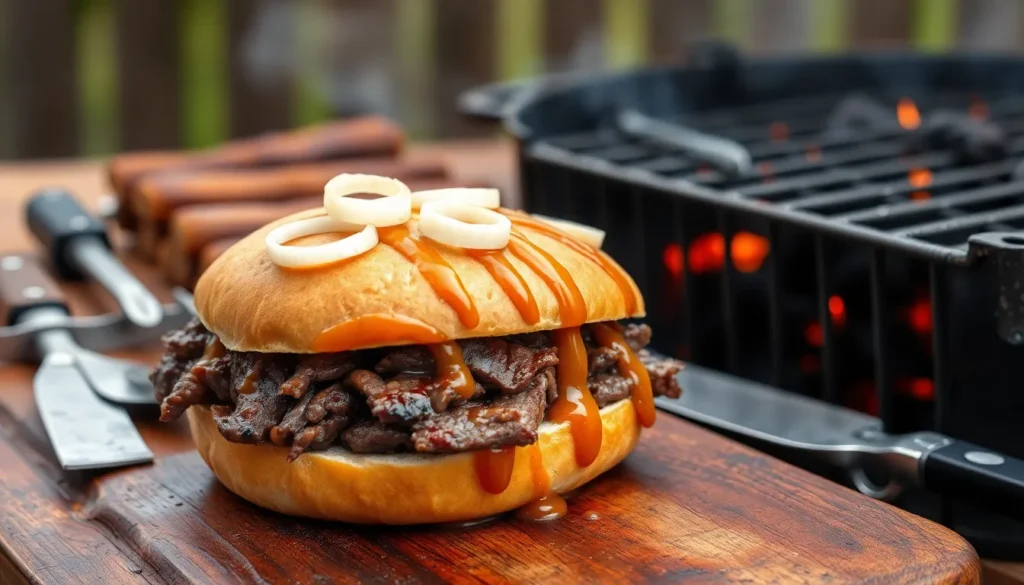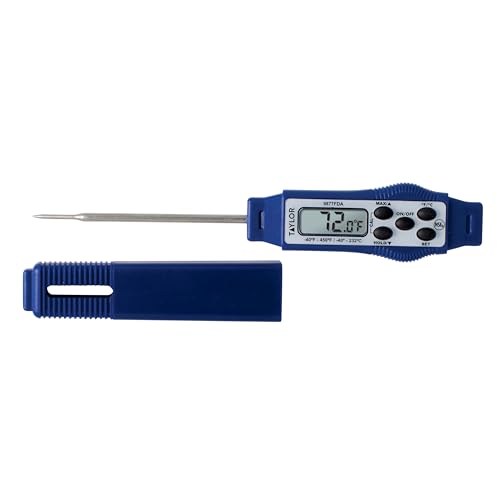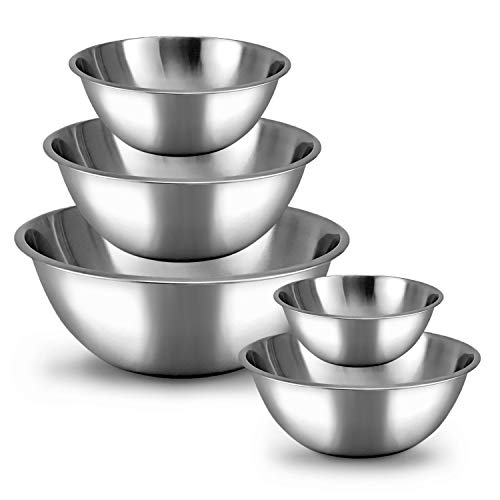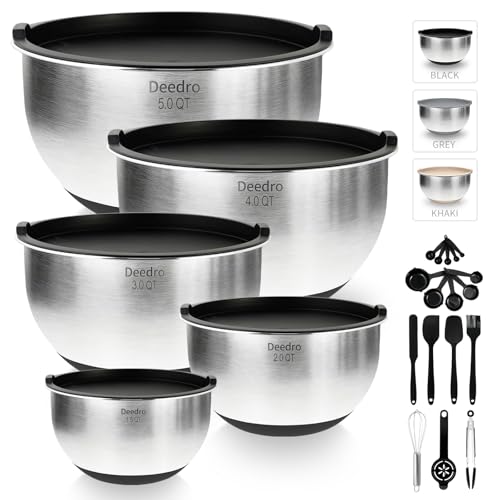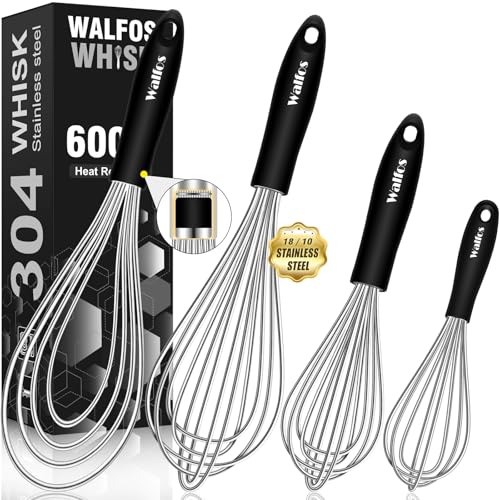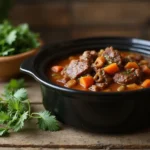When we think of Baltimore’s culinary treasures pit beef immediately comes to mind. This smoky sliced beef sandwich represents the heart and soul of Charm City’s barbecue tradition. Born from the city’s working-class neighborhoods pit beef has become an iconic dish that locals and visitors can’t resist.
We’ve perfected this authentic Baltimore pit beef recipe that captures the essence of roadside stands and family gatherings throughout Maryland. The secret lies in the perfect balance of slow-smoking techniques and the right cut of beef that creates those signature charred edges and tender pink interior.
What makes Baltimore pit beef truly special isn’t just the smoking process – it’s the way thin-sliced beef gets piled high on a fresh roll with tiger sauce and onions. We’ll show you how to recreate this beloved sandwich right in your own backyard using traditional methods that Baltimore pitmasters have perfected over decades.
What Is Baltimore Pit Beef
Baltimore pit beef stands as the city’s signature barbecue dish that showcases the art of smoking beef over charcoal pits. We find this iconic sandwich built around thinly sliced beef that gets smoked low and slow until it develops a distinctive charred exterior while maintaining tender pink meat inside.
The dish originated in Baltimore’s blue collar neighborhoods during the 1970s when local pitmasters began experimenting with smoking beef instead of the more traditional pork. These early innovators created a unique style that differs significantly from other regional barbecue traditions across the United States.
We observe that authentic Baltimore pit beef uses exact cuts of beef, typically top round or bottom round roasts, which get seasoned with a simple dry rub before hitting the smoker. The smoking process occurs over charcoal and wood at temperatures between 225°F and 250°F for several hours until the meat reaches the perfect balance of smoke penetration and tenderness.
Traditional pit beef gets sliced paper thin while still warm from the smoker and piled high on a Kaiser roll or rye bread. The sandwich construction follows a exact pattern that Baltimore locals recognize immediately. We layer the warm beef generously, then top it with raw white onions and the famous tiger sauce, which combines horseradish and mayonnaise for a sharp creamy kick.
Local pit beef stands throughout Baltimore serve this dish alongside other regional favorites, creating a barbecue culture that remains distinctly different from Southern or Kansas City styles. The meat maintains a beautiful smoke ring and develops a slightly charred crust called “bark” that provides textural contrast to the tender interior.
We appreciate how Baltimore pit beef represents more than just a sandwich – it embodies the working class spirit and culinary innovation that defines this Mid Atlantic city’s food scene.
Essential Equipment for Pit Beef
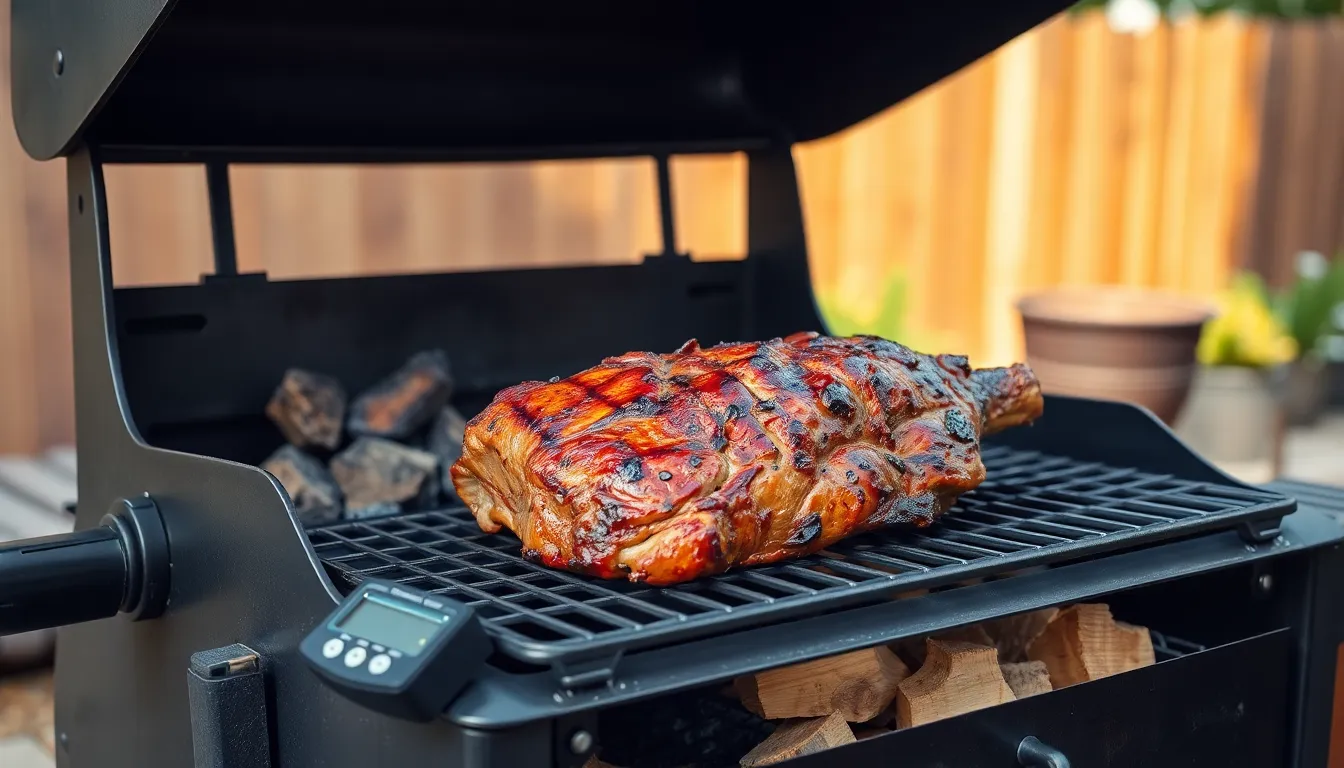
Creating authentic Baltimore pit beef requires exact equipment that allows us to achieve the characteristic charred exterior and tender interior. The right tools make the difference between a good sandwich and an exceptional one.
Charcoal Grill Setup
We need a charcoal grill that accommodates two-zone cooking for proper pit beef preparation. One side should hold hot coals for searing while the other side remains cooler for indirect cooking. A chimney starter becomes essential for lighting charcoal efficiently and evenly.
The cooking grate requires preheating, cleaning, and oiling before we place the beef roast on it. This preparation ensures proper searing and prevents the meat from sticking during the initial high-heat phase. Our grill must provide enough space to move the roast between zones seamlessly.
| Grill Zone | Temperature | Purpose |
|---|---|---|
| Hot Side | Direct Heat | Searing all sides |
| Cool Side | 225-250°F | Indirect cooking |
Wood Selection
Traditional Baltimore pit beef relies on lump charcoal as the primary fuel source. We can enhance the smoky flavor by adding hardwood chunks or chips such as hickory or oak to the charcoal bed. The focus remains on quick searing followed by indirect cooking rather than extended smoking.
Lump charcoal burns hotter and cleaner than briquettes, providing the intense heat needed for creating that signature charred bark. Wood chunks work better than chips because they burn longer and produce more consistent smoke throughout the cooking process.
Temperature Tools
An instant-read digital meat thermometer becomes our most critical tool for monitoring internal beef temperature accurately. We target 115-120°F for rare to medium-rare doneness before removing the roast from heat. A grill temperature gauge helps us maintain the indirect cooking zone around 225-250°F during the slower cooking phase.
Precise temperature control prevents overcooking the beef, which would result in tough, dry meat instead of the tender slices that define authentic Baltimore pit beef. We recommend checking the internal temperature every 15-20 minutes once the roast moves to the indirect heat zone.
Ingredients
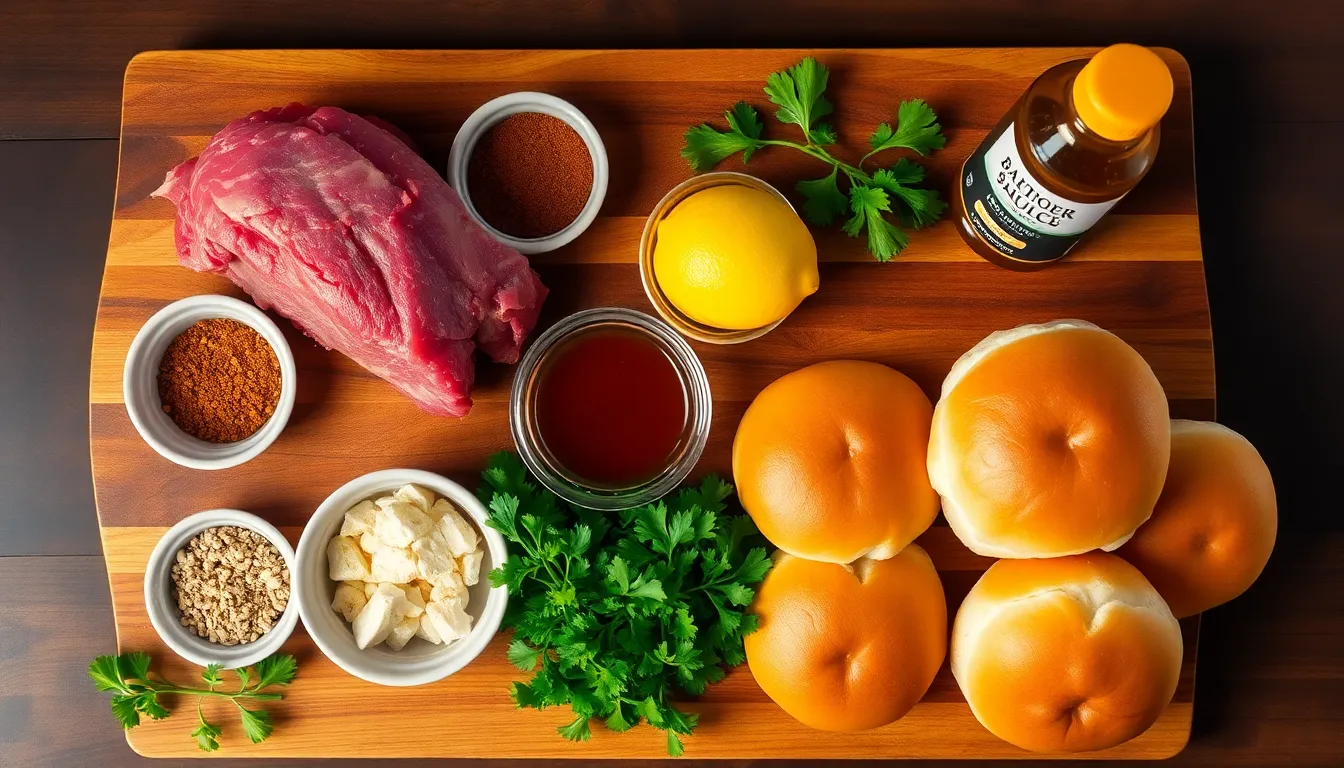
Creating authentic Baltimore pit beef requires carefully selected ingredients that deliver the signature smoky flavor and distinctive tiger sauce. We’ve organized these ingredients by component to make your shopping and preparation simple.
For the Beef
- 3 to 5 pounds beef bottom round or top round roast
- 2 tablespoons olive oil (for binding the dry rub)
For the Dry Rub
- 1/4 cup all-purpose BBQ seasoning (Killer Hogs AP Seasoning preferred)
- 1 tablespoon onion powder
- 1 tablespoon chili powder
- 1 tablespoon paprika
- 1 teaspoon mustard powder
- Seasoned salt and pepper (optional for extra flavor)
For the Tiger Sauce
- 1/2 to 3/4 cup mayonnaise (Blue Plate mayonnaise preferred)
- 1/4 cup prepared horseradish
- 2 tablespoons sour cream (optional)
- 1 teaspoon mustard flour (optional)
- 2 teaspoons all-purpose seasoning or seasoned salt
- Squeeze of fresh lemon juice
- Pinch of salt and black pepper
For Serving
- Kaiser rolls or sandwich buns
- Thinly sliced sweet or white onions (raw)
Prep Instructions
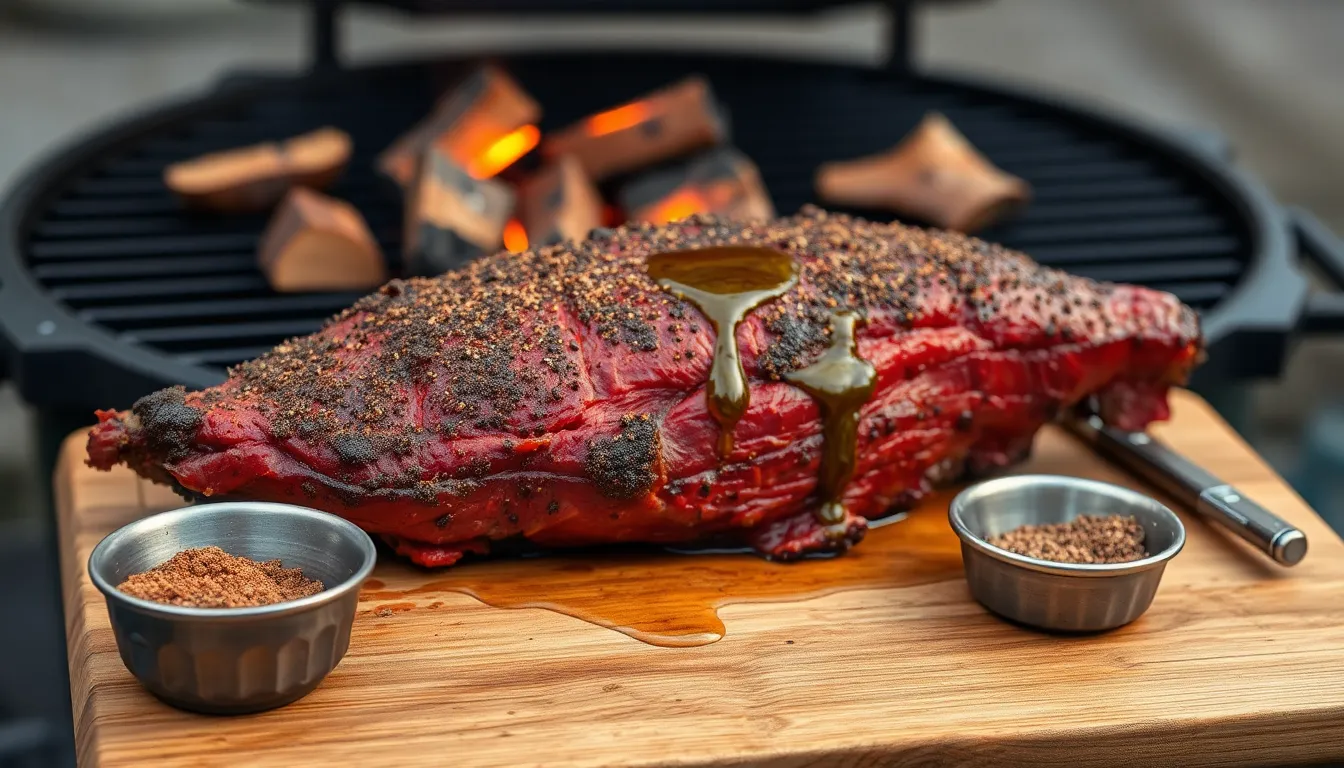
Now that we have our ingredients ready, let’s walk through the essential preparation steps to create authentic Baltimore pit beef. Proper preparation is crucial for achieving that signature charred exterior and tender interior.
Preparing the Beef
We start with our 3 to 5-pound top or bottom round beef roast. Drizzle olive oil generously over the entire surface of the beef roast to create a binding agent for our dry rub seasoning. Pat the meat dry with paper towels before applying the oil to ensure better adherence.
Apply our dry rub mixture evenly across the entire roast, pressing the seasoning into the meat to create good coverage on all surfaces. Work the spice blend into every crevice and fold of the beef for maximum flavor penetration. Allow the seasoned roast to rest at room temperature for 30 to 45 minutes before cooking to let the flavors meld and the meat come to room temperature.
Making the Dry Rub
Combine all dry rub ingredients in a small mixing bowl for easy blending. Mix 1/4 cup all-purpose seasoning with 1 tablespoon each of onion powder, chili powder, and paprika. Add 1 teaspoon mustard powder to the blend and whisk thoroughly until all spices are evenly distributed.
This combination creates the characteristic smoky and spicy crust that Baltimore pit beef is known for. Store any leftover dry rub in an airtight container for future use, as this blend works excellently on other cuts of beef as well.
Setting Up Your Grill
Prepare your charcoal grill using lump coal or hardwood charcoal for the most authentic smoky flavor profile. Light the charcoal and arrange it to create two distinct cooking zones: one side with hot direct heat for searing and another side with cooler indirect heat for slow cooking.
Maintain the hot zone at high temperature for initial searing while keeping the cooler zone at 225 to 250°F for the slow cooking phase. Add hardwood chunks like hickory or oak to the hot coals for additional smoke flavor. Position your grill grates about 6 inches above the coals and allow the grill to preheat for 10 to 15 minutes before placing the beef on the cooking surface.
Cooking Instructions
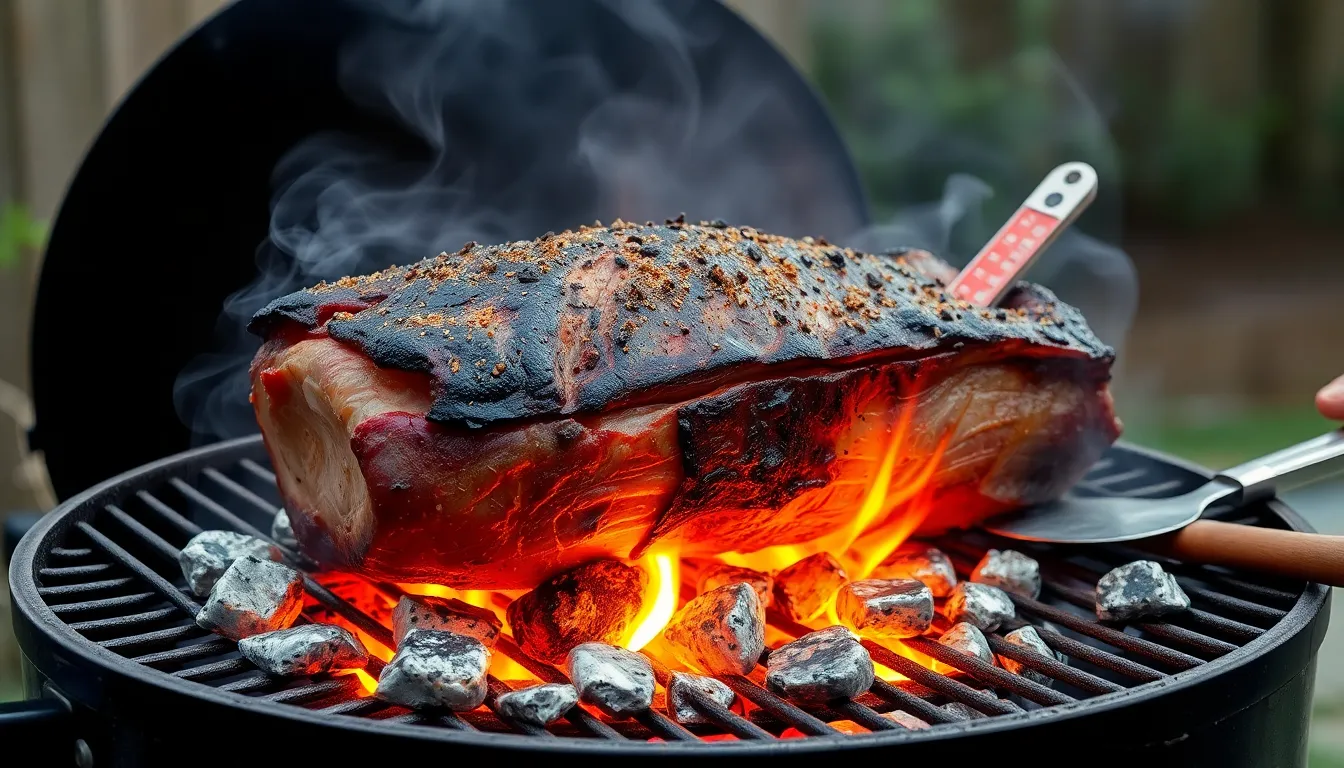
Now we’ll transform our seasoned roast into authentic Baltimore pit beef using the traditional two-stage cooking method. This process combines high-heat searing with low and slow indirect cooking to achieve the perfect balance of smoky flavor and tender texture.
Initial Searing
We start by placing our seasoned roast directly over the hot coals on the direct cooking side of our grill. The high heat creates that essential charred crust that gives pit beef its distinctive bark and locks in the juices. We sear each side of the roast for 2-3 minutes, turning frequently to develop an even, dark crust on all surfaces.
During this searing phase, we watch for the internal temperature to reach approximately 120°F using our instant-read thermometer. The olive oil coating helps create beautiful caramelization while the spice blend forms a flavorful crust. We continue rotating the roast every few minutes until all sides develop that characteristic dark bark.
Low and Slow Cooking
Once we achieve proper searing, we move the roast to the cooler indirect side of our grill where temperatures hover between 225-250°F. This transition from high heat to low and slow cooking allows the tough fibers in the round roast to break down gradually while maintaining moisture.
We adjust our grill vents to maintain consistent temperature in this range, adding hardwood chunks as needed to maintain steady smoke production. The roast continues cooking in this indirect zone, rotating occasionally to ensure even heat distribution. This slow cooking phase typically takes 1-2 hours depending on the size of our roast and desired doneness level.
Monitoring Temperature
We use our instant-read digital meat thermometer to track the internal temperature throughout the cooking process. For authentic Baltimore pit beef, we target 115-120°F for rare to medium-rare doneness, which provides the ideal texture for thin slicing.
| Doneness Level | Internal Temperature |
|---|---|
| Rare | 115°F |
| Medium-Rare | 120-130°F |
Once we reach our target temperature, we remove the roast from the grill and let it rest for 10-20 minutes. This resting period allows the juices to redistribute throughout the meat, ensuring each slice remains tender and juicy when we carve it thin for our sandwiches.
Making Tiger Sauce
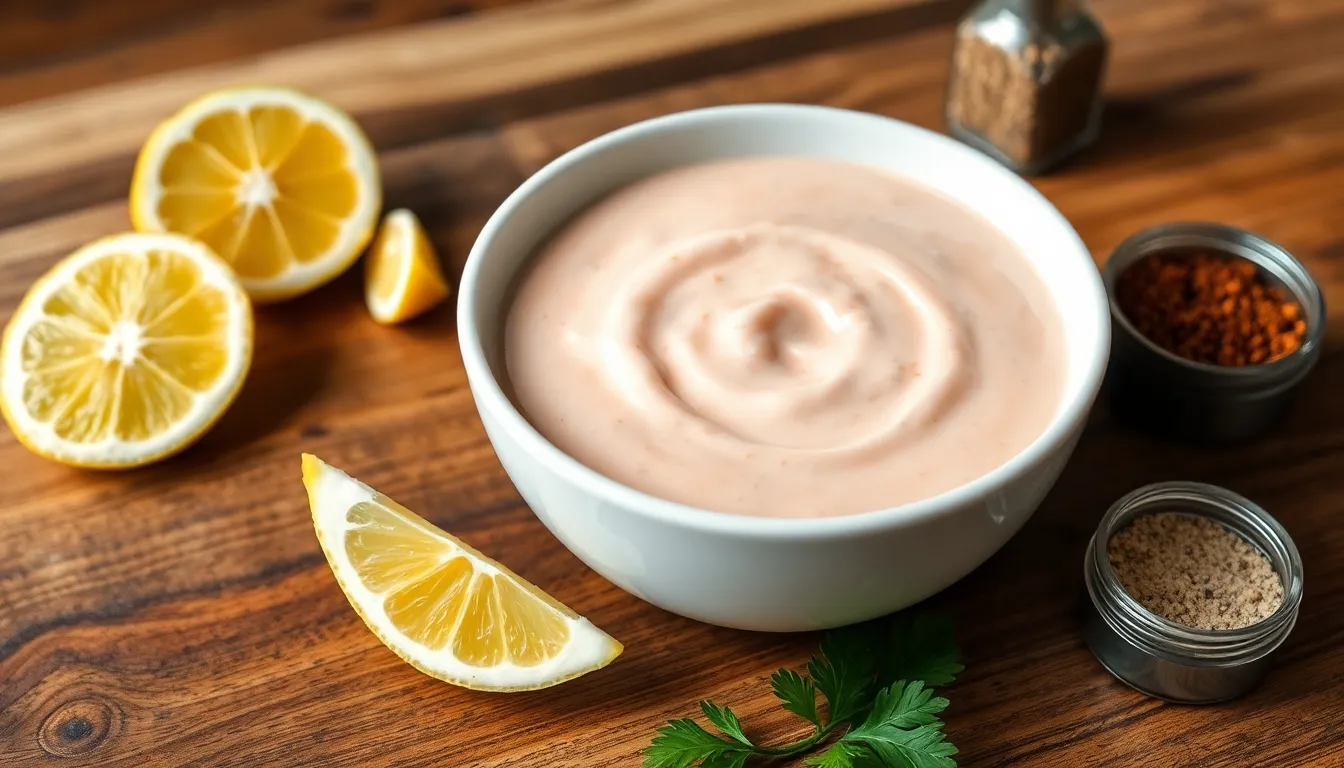
We create Baltimore’s signature tiger sauce using just a few essential ingredients that deliver the perfect balance of creamy richness and sharp heat. This iconic condiment elevates pit beef sandwiches with its distinctive horseradish kick and smooth mayonnaise base.
Tiger Sauce Ingredients
- 3/4 cup mayonnaise (Blue Plate brand provides authentic flavor)
- 1/4 cup prepared horseradish
- Juice from a lemon wedge
- 2 teaspoons all-purpose BBQ seasoning (such as Killer Hogs AP Seasoning)
Preparation Steps
We start by measuring the mayonnaise into a small mixing bowl. Blue Plate mayonnaise works best for authentic Baltimore flavor, though any quality brand produces excellent results. Next, we add the prepared horseradish directly to the mayonnaise. Fresh horseradish creates too intense a flavor, so we stick with the prepared version for consistent heat levels.
The fresh lemon juice brightens the sauce and cuts through the richness of the mayonnaise. We squeeze the lemon wedge directly into the bowl, removing any seeds that might fall in. Our all-purpose BBQ seasoning rounds out the flavor profile with savory depth and mild spice.
Mixing and Resting
We whisk all ingredients together thoroughly until the mixture appears completely uniform. The sauce should have a pale pink color from the horseradish and maintain a smooth, creamy consistency. Proper mixing ensures every bite of the sandwich gets the same balanced flavor.
After mixing, we transfer the tiger sauce to the refrigerator for at least one hour before serving. This resting period allows the flavors to meld together and the horseradish heat to distribute evenly throughout the sauce. The longer resting time creates a more cohesive flavor profile that perfectly complements the smoky pit beef.
We store leftover tiger sauce in an airtight container in the refrigerator for up to one week. The sauce actually improves after the first day as the flavors continue to develop and intensify.
Slicing and Serving
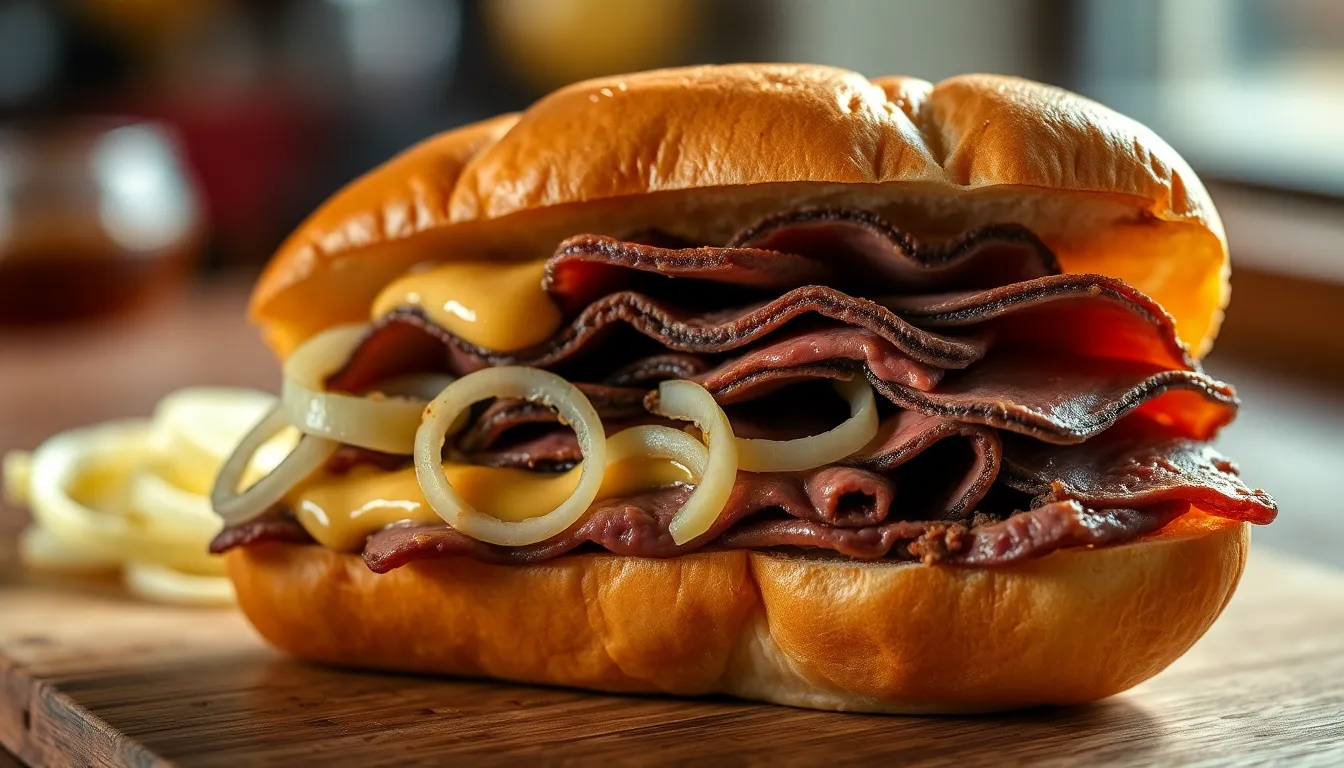
Once our pit beef reaches perfect doneness and has rested properly, we move to the crucial final steps that transform our smoky roast into authentic Baltimore sandwiches. These techniques ensure every bite delivers the tender texture and bold flavors that define this beloved regional specialty.
Proper Slicing Technique
We must allow our cooked roast to rest for at least 20 to 30 minutes after removing it from the grill. This resting period can extend up to 2 hours when kept in a cooler, allowing the juices to redistribute throughout the meat for maximum tenderness.
The most critical aspect of serving pit beef lies in slicing it thinly against the grain. We identify the direction of the muscle fibers and cut perpendicular to them, creating tender pieces that are easy to chew. A meat slicer produces the ideal deli-thin slices, though a sharp knife works effectively when we maintain consistent thin cuts.
| Resting Time | Temperature Range | Slicing Method |
|---|---|---|
| 20-30 minutes minimum | 115-120°F internal | Against the grain |
| Up to 2 hours in cooler | Rare to medium-rare | Deli-thin slices |
Our target internal temperature of 115 to 120°F ensures the meat remains rare to medium rare, providing the signature pink interior beneath the deeply caramelized exterior bark.
Assembly on Kaiser Rolls
We build our authentic Baltimore pit beef sandwich using a sturdy Kaiser roll as our foundation. The assembly process follows a exact order that balances flavors and textures perfectly.
We start by spreading a generous layer of Tiger sauce across the bottom half of our Kaiser roll. This creamy horseradish-based sauce combines mayonnaise, sour cream, prepared horseradish, mustard flour, and seasonings to create the signature tangy kick that complements our smoky beef.
Next, we pile our thinly sliced pit beef onto the sauced bun, creating a substantial mound of meat. The warm, tender slices should be layered generously to achieve the authentic Baltimore experience.
We top the beef with thinly sliced white onions, which provide a sharp, fresh crunch that cuts through the richness of the meat and sauce. These raw onions add both texture and a pungent bite that enhances each mouthful.
Finally, we cap our sandwich with the top half of the Kaiser roll and serve immediately while the beef remains warm. This classic combination delivers the perfect balance of smoky rare beef, creamy spicy Tiger sauce, and crisp pungent onions all contained within a slightly crusty yet soft roll.
Storage and Reheating Tips
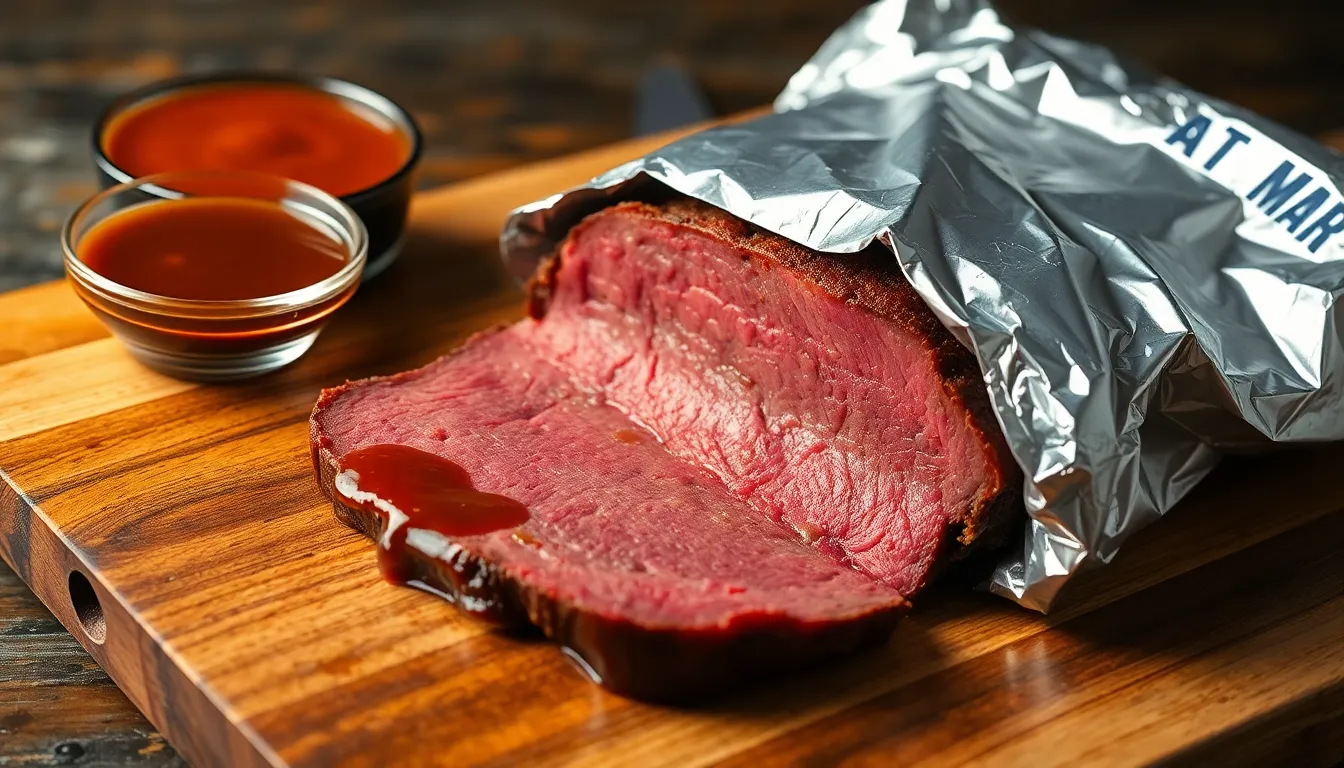
Proper storage of leftover pit beef ensures we can enjoy this Baltimore classic beyond our initial meal. We recommend transferring any remaining sliced beef to an airtight container and refrigerating it within two hours of cooking. Our pit beef maintains optimal quality for 3-4 days when stored correctly in the refrigerator.
Gentle reheating preserves the tender texture and smoky flavor we worked hard to achieve. We suggest warming the beef slices in a low oven set to 250°F, wrapping them in aluminum foil to prevent moisture loss. This method takes approximately 10-15 minutes and prevents the meat from becoming tough or dried out.
Microwave reheating offers a quicker alternative when time is limited. We cover the sliced beef with a damp paper towel and heat in 30-second intervals, checking frequently to avoid overcooking. This technique helps maintain moisture while ensuring even heating throughout the meat.
High temperatures destroy the delicate texture of properly cooked pit beef. We avoid reheating at temperatures above 300°F or using direct heat methods like stovetop searing. These aggressive heating methods can quickly transform our tender slices into chewy, disappointing leftovers.
Timing our reheating process correctly enhances the overall sandwich experience. We warm the beef just before assembling our sandwiches to preserve the authentic smoky flavor and natural juiciness. Cold tiger sauce pairs perfectly with warm beef, creating the temperature contrast that makes Baltimore pit beef sandwiches so satisfying.
Individual portion storage makes weekday lunches more convenient. We divide leftover pit beef into single-serving containers, allowing us to reheat only what we need. This approach prevents repeated heating cycles that can compromise the meat’s quality and flavor profile.
Variations and Substitutions
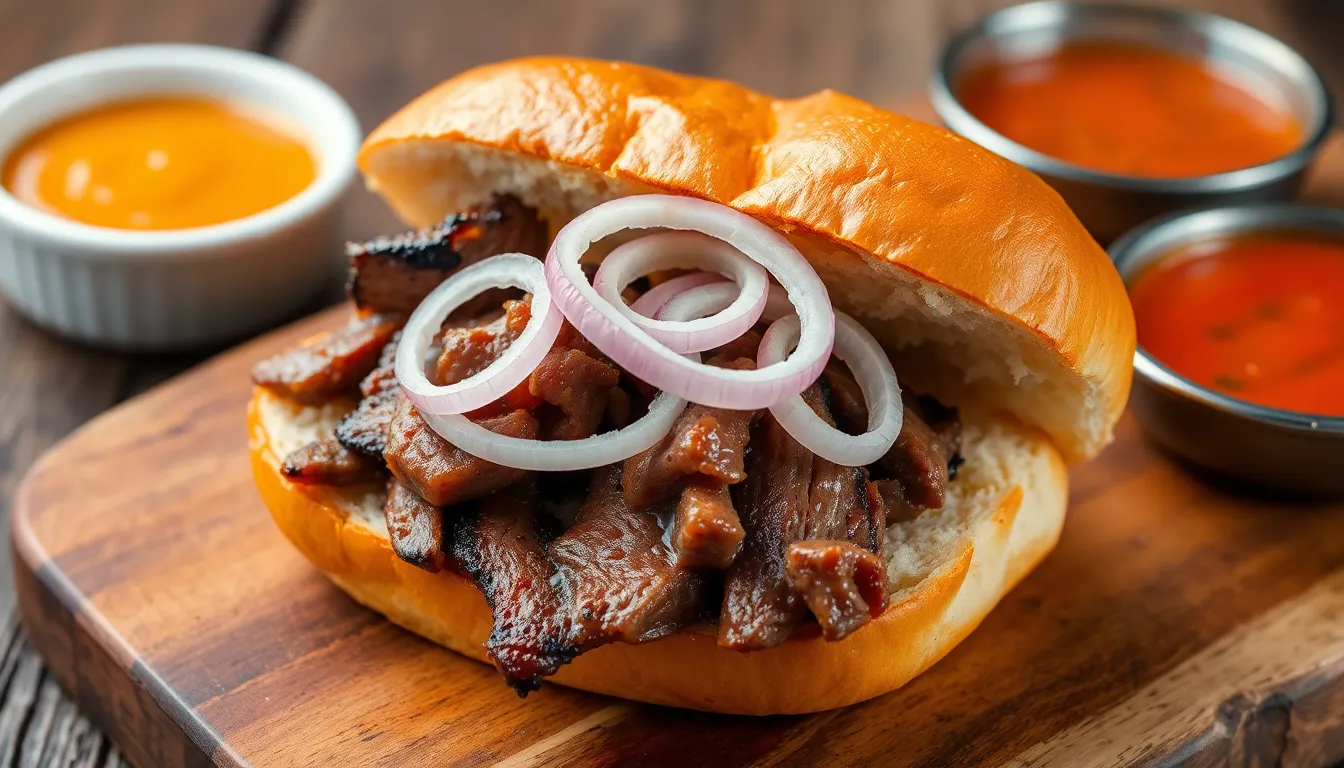
While traditional Baltimore pit beef maintains its classic simplicity, we understand that home cooks appreciate flexibility to customize this beloved sandwich to their taste preferences and available ingredients.
Beef Cut Alternatives
We recommend top round or bottom round roasts for authentic pit beef, but eye of round presents an excellent substitute when your butcher doesn’t stock the traditional cuts. Chuck roast offers a more marbled option that remains tender even if slightly overcooked, though it produces a different texture than the classic lean cuts. For those seeking premium results, we suggest tri-tip or sirloin tip roasts, which deliver exceptional flavor while maintaining the proper texture for thin slicing.
Sauce Modifications
Our tiger sauce recipe serves as the foundation, but we encourage experimentation with the horseradish intensity. Double the prepared horseradish for those who prefer extra heat, or reduce it by half for milder palates. Some Baltimore establishments add yellow mustard to their tiger sauce for tanginess, while others incorporate a splash of apple cider vinegar for brightness. We’ve found that substituting Greek yogurt for half the mayonnaise creates a lighter version without sacrificing creaminess.
Seasoning Adjustments
The dry rub welcomes personal touches while maintaining its sugar-free profile to prevent burning. We often add garlic powder and black pepper for depth, or incorporate smoked paprika for enhanced smokiness. Regional variations include Old Bay seasoning, which pays homage to Maryland’s seafood heritage. For those who prefer heat, cayenne pepper or chipotle powder integrate seamlessly into the blend.
Bread and Topping Options
Kaiser rolls remain the gold standard, but we’ve successfully used onion rolls, Portuguese rolls, or even thick slices of rye bread when Kaiser rolls aren’t available. The raw white onions provide traditional crunch, though red onions offer a sharper bite. We sometimes substitute thinly sliced pickles for guests who prefer tangy alternatives to onions, and coleslaw adds extra texture while staying true to Maryland’s barbecue tradition.
Cooking Method Adaptations
Charcoal grilling produces the most authentic results, but we recognize that gas grills work when supplemented with wood chips for smoke flavor. Indoor preparation becomes possible using a combination of oven roasting at 275°F after initial searing in a cast iron skillet. For apartment dwellers, we suggest using a smoker box on a gas grill or even a stovetop smoker for similar results, though the char won’t be as pronounced as traditional pit cooking methods.
Conclusion
We’ve walked you through every step of creating authentic Baltimore pit beef right in your backyard. From selecting the perfect cut of beef to mastering the two-zone grilling technique this recipe brings Baltimore’s beloved sandwich tradition to your table.
The combination of smoky charred beef tender slicing and that signature tiger sauce creates something truly special. Whether you’re a barbecue enthusiast or someone looking to explore regional American cuisine this pit beef recipe delivers genuine Baltimore flavors.
Fire up your grill gather your ingredients and get ready to experience why Baltimore locals have been obsessing over this sandwich for decades. Your taste buds will thank you for this delicious journey into Maryland’s barbecue heritage.
Frequently Asked Questions
What is Baltimore pit beef?
Baltimore pit beef is a local barbecue specialty featuring thinly sliced, smoky beef served on a Kaiser roll or rye bread. Originating in Baltimore’s working-class neighborhoods in the 1970s, this iconic sandwich is topped with raw white onions and tiger sauce (a horseradish-mayo blend). The beef is slow-smoked over charcoal and wood at 225-250°F, creating a charred exterior “bark” and tender interior.
What cut of beef is best for pit beef?
Top round or bottom round roasts are the traditional choices for authentic Baltimore pit beef. These cuts, typically 3-5 pounds, work best because they develop excellent flavor when slow-smoked while maintaining tenderness when sliced thin. Eye of round and chuck roast can serve as alternatives, though they may require slight adjustments in cooking time and technique.
What is tiger sauce and how do you make it?
Tiger sauce is Baltimore’s signature condiment for pit beef, made with mayonnaise, prepared horseradish, lemon juice, and BBQ seasoning. Simply mix these ingredients until uniform and refrigerate for at least an hour to let flavors meld. The sauce provides a creamy richness with a sharp horseradish kick that perfectly complements the smoky beef.
What temperature should pit beef be cooked to?
Pit beef should be cooked to an internal temperature of 115-120°F for rare to medium-rare doneness. Use a digital meat thermometer to monitor temperature throughout cooking. The meat is first seared over high heat to develop a charred crust, then moved to indirect heat at 225-250°F for slow cooking until it reaches the target temperature.
Can I make pit beef without a charcoal grill?
While charcoal grilling is traditional and preferred for authentic flavor, you can adapt the recipe for gas grills or indoor cooking methods. Gas grills should be set up for two-zone cooking with wood chips for smoke. Indoor alternatives include using a smoker, oven with liquid smoke, or pellet grill, though the flavor profile may differ slightly from the original.
How do you slice and serve pit beef?
After cooking, let the roast rest for 20-30 minutes before slicing. Cut the beef very thin against the grain for maximum tenderness. Serve immediately on sturdy Kaiser rolls with tiger sauce spread on the bottom, a generous mound of warm sliced beef, and topped with raw white onions for crunch and flavor contrast.
How long does leftover pit beef keep?
Leftover pit beef should be refrigerated in an airtight container within two hours of cooking and will keep for 3-4 days. For reheating, use gentle methods like a low oven or microwave with a damp paper towel to preserve texture. Store individual portions for convenience, and avoid high-temperature reheating that could dry out the meat.
What equipment do I need to make pit beef?
Essential equipment includes a charcoal grill capable of two-zone cooking, lump charcoal for clean burning, hardwood chunks (hickory or oak), and a digital meat thermometer. You’ll also need basic grilling tools and a sharp knife for slicing. The two-zone setup allows for both high-heat searing and low-temperature indirect cooking necessary for authentic pit beef.

